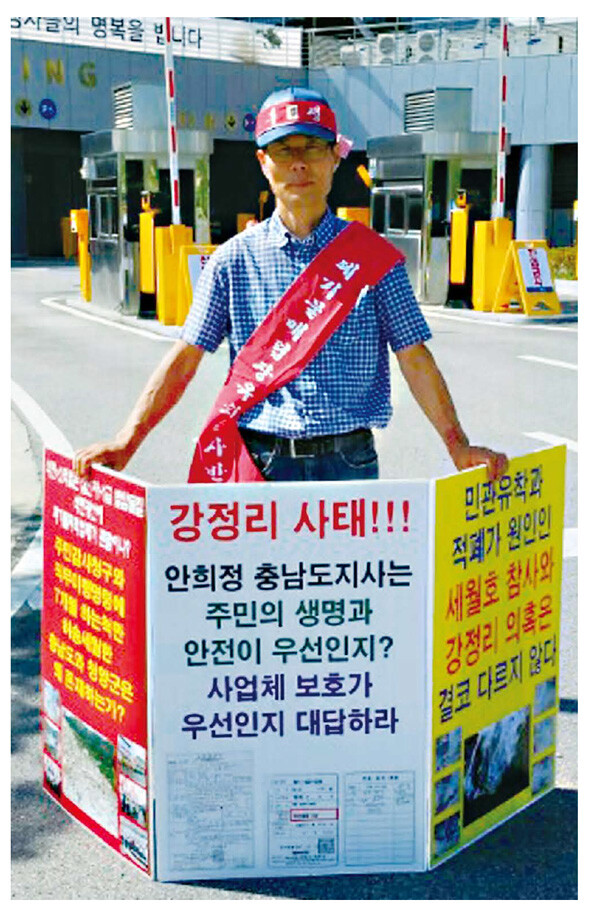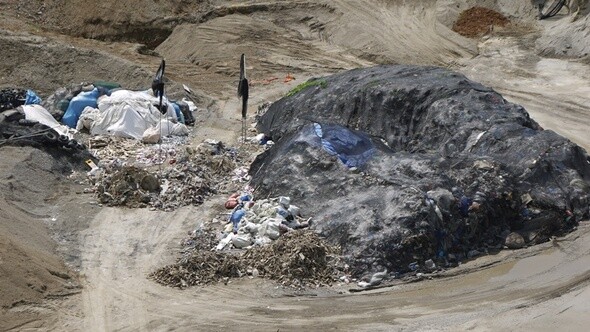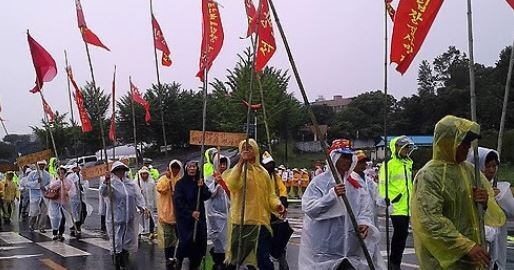hankyoreh
Links to other country sites 다른 나라 사이트 링크
[Special reportage] Village being choked off by reckless asbestos mining

By Jeon Jin-sik, South Chungcheong correspondent
Gangjeong Village, site of recent protests against the building of a naval base, is located on the coast of Jeju Island. Another village called Gangjeong can be found in South Chungcheong Province, on the foothills of Mt. Chilgap. This other Gangjeong is home to a construction waste disposal site where an asbestos mine is located. Now the by-products of the mining are eating away at the livelihoods of residents - yet the province, and the county of Cheongyang, where the village is located, seem unwilling to deal with problem. Fed-up villagers have responded by coming out daily for protests wearing funeral clothes.Kim Do-yeon, a 54-year-old resident of the village in the township of Bibong and head of the local women’s association, lost her mother-in-law in 2007.
“She just wasted away slowly,” Kim said. “She lost so much weight she looked like a toothpick. She couldn’t go a day without painkillers, and at night she coughed so hard there was blood coming out.”
Even the hospitals she visited could not identify the exact ailment. It was only four months before her death that Kim’s mother-in-law was diagnosed with mesothelioma by the Korea Cancer Center Hospital in Seoul. The culprit was the “unseen killer”: asbestos, a Class 1 carcinogen.
“My stepmother worked for years in a field right next to the intermediate construction waste processing site where the asbestos mine was,” Kim said. “My husband worked alongside her, and now he’s terrified every time he coughs up phlegm.”

Gangjeong is the only place in the country where facilities that generate particulate matter - like an intermediate construction waste processing site - are located in an asbestos mine. Residents of the village have gotten progressively sicker since the company Bomin Environmental began operating its plant in 2001. Lee Ki-tae, an 80-year-old resident, was diagnosed with Level 2 asbestosis in April 2011. Now even walking a few steps leaves him feeling choked; he can’t travel around the village without using a motorbike. He does get some coverage for medicine at the free clinic, but the journey takes so much out of him that he essentially has no choice but to pay out of pocket for the drugs.
“My cough has been so bad that I’ve been taken away in an ambulance a few times for coughing my sink full of blood,” he said.
Lee is among ten villagers so far who have been recognized by the Korea Environment Corporation as suffering asbestos-related damages. Five have died already.
The residents’ findings on the asbestos damage situation from their own investigation this year go far beyond what official figures suggest. Gangjeong villagers went from house to house interviewing 500 residents their village and nearby and found 35 deaths from lung cancer. The national average for patients suffering asbestos-related ailments is around two out of every 100,000 people; there, the rate was more than 300 times higher. Seventy-two-year-old Noh Hyeong-sik, a lifelong village resident and general secretary of the local senior citizens’ association, suffers difficulties walking and breathing, yet he still has not had his condition recognized as asbestos-related.
Village head Lee Tae-yeong, 65, was distraught.
“Each day of living is like dying,” he said. “What does it say when people are out there doing one-person demonstrations in funeral clothes?”

For over a decade after the factory opened, residents had no idea of the dangers of asbestos. It was only when around 50 of them attended an Aug. 25 debate on the village’s asbestos and waste problem organized by the South Chungcheong Provincial Office and heard an explanation from Asian Citizens’ Center for Environmental Health chief Choi Ye-yong that they learned the substance was present in the air they breathed in every day. “The county office never said a word about it,” said one of many angered residents at the village center on Aug. 28.
Indeed, the actions taken by Cheongyang County have only fueled the residents’ anger. Lee Seok-hwa, the county chief, paid no visits to the village during the recent campaign for the municipal elections on June 4. Even in a tight election where every vote counted, Gangjeong’s 279 residents went ignored. After he won election, Lee continued to ignore Gangjeong in his tours of the county’s various townships.
At the debate, deputy chief Jeong Song said a solution “could be sought with the central government if residents work together” - a response that was met with fierce objections from villagers. Jeong is also a former environmental management officer with the county, whose work was related to Bomin Environmental. The only administrative actions taken against the company by the county have been two suspensions and a few thousands of dollars in fines.
Also getting in the way of a resolution is the hands-off attitude of South Chungcheong province and its governor Ahn Hee-jung. In Dec. 2013, residents worked with civic groups to demand the province conduct a resident audit, which was eventually carried out in February by the provincial audit committee. But no drilling samples were ever taken from the places where residents claimed companies had illegally buried asbestos and waste. The entire investigation lasted four days.
Residents said the lackluster performance further undercut the province’s boasting about being the first local government in the country to set up its own independent audit committee. Angry with what they saw as a perfunctory investigation, they petitioned Ahn to issue a job performance order by the Local Autonomy Act requiring Cheongyang County to take suitable action and conduct appropriate guidance and inspections for “B” Environmental. The order was issued, but the province ended up granting two extensions for the county’s reply, a process that lasted over five months. It never attempted the vicarious administrative executive prescribed in the Local Autonomy Act.
“If the county replies by Aug. 31, then we’ll review the response message after we receive their answer,” said Kim Chan-bae, head of the province’s administrative team.

Residents of Gangjeong began holding one-person demonstrations in front of South Chungcheong Provincial Office and Cheongyang County Office on July 7. Nearly two months later, they’re still at it. Well over a year has passed since they set up a guard post on a hill beneath the plant in the spring of 2013 to monitor for illegal waste burial.
“These are senior citizens who are busy with farming and are not in the best of health,” said Kwon Oh-bok, the 56-year-old head of the residents’ countermeasures committee. “They’ve organized teams to sit at the guard post monitoring the plant from 7:30 in the morning to 5 in the afternoon every day.”
Residents and civic groups are demanding the immediate shutdown of the plant, safe mine closure measures, and full-scale health examinations for villagers. During the province’s debate, Choi Ye-yong singled out the “urgent need to revoke the company’s permit, close the mine safely, restore the environment, and monitor resident health.” On Aug. 29, a group of 150 residents and local civic group members formed human chains around the provincial and county offices to demand a solution.
“South Chungcheong Province and Cheongyang County are putting business profits ahead of resident lives,” said Lee Sang-seon, head of the Cheongyang Citizens’ Alliance. “They’ve made a mockery of the resident audit request and the job performance order system, and they’ve abandoned their own residents.”
“As governor, Ahn Hee-jung has talked about being in favor of administrative reforms,” Lee continued. “How long is he going to sit there and do nothing about these claims of collusion between the company and the administrative agencies?”
Please direct questions or comments to [english@hani.co.kr]

Editorial・opinion
![[Column] Has Korea, too, crossed the Rubicon on China? [Column] Has Korea, too, crossed the Rubicon on China?](https://flexible.img.hani.co.kr/flexible/normal/500/300/imgdb/original/2024/0419/9317135153409185.jpg) [Column] Has Korea, too, crossed the Rubicon on China?
[Column] Has Korea, too, crossed the Rubicon on China?![[Correspondent’s column] In Japan’s alliance with US, echoes of its past alliances with UK [Correspondent’s column] In Japan’s alliance with US, echoes of its past alliances with UK](https://flexible.img.hani.co.kr/flexible/normal/500/300/imgdb/original/2024/0419/2317135166563519.jpg) [Correspondent’s column] In Japan’s alliance with US, echoes of its past alliances with UK
[Correspondent’s column] In Japan’s alliance with US, echoes of its past alliances with UK- [Editorial] Does Yoon think the Korean public is wrong?
- [Editorial] As it bolsters its alliance with US, Japan must be accountable for past
- [Guest essay] Amending the Constitution is Yoon’s key to leaving office in public’s good graces
- [Editorial] 10 years on, lessons of Sewol tragedy must never be forgotten
- [Column] A death blow to Korea’s prosecutor politics
- [Correspondent’s column] The US and the end of Japanese pacifism
- [Guest essay] How Korea turned its trainee doctors into monsters
- [Guest essay] As someone who helped forge Seoul-Moscow ties, their status today troubles me
Most viewed articles
- 1[Column] The clock is ticking for Korea’s first lady
- 2After 2 months of delayed, denied medical care, Koreans worry worst may be yet to come
- 3Hong Se-hwa, voice for tolerance whose memoir of exile touched a chord, dies at 76
- 4[Column] Has Korea, too, crossed the Rubicon on China?
- 5US overtakes China as Korea’s top export market, prompting trade sanction jitters
- 6Samsung barricades office as unionized workers strike for better conditions
- 7[Editorial] As it bolsters its alliance with US, Japan must be accountable for past
- 8[Correspondent’s column] In Japan’s alliance with US, echoes of its past alliances with UK
- 9All eyes on Xiaomi after it pulls off EV that Apple couldn’t
- 10[Correspondent’s column] The US and the end of Japanese pacifism